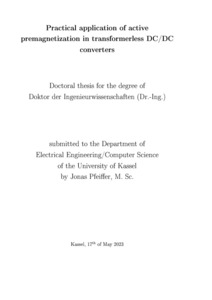| dc.date.accessioned | 2023-05-22T14:26:11Z | |
| dc.date.available | 2023-05-22T14:26:11Z | |
| dc.date.issued | 2023-05-17 | |
| dc.identifier | doi:10.17170/kobra-202211117096 | |
| dc.identifier.uri | http://hdl.handle.net/123456789/14737 | |
| dc.language.iso | eng | eng |
| dc.rights | Namensnennung - Weitergabe unter gleichen Bedingungen 4.0 International | * |
| dc.rights.uri | http://creativecommons.org/licenses/by-sa/4.0/ | * |
| dc.subject.ddc | 620 | |
| dc.title | Practical application of active premagnetization in transformerless DC/DC converters | eng |
| dc.type | Dissertation | |
| dcterms.abstract | Magnetic devices are used in almost every power electronic system. Therefore, their purpose and with that their requirements can vary in a wide range. The consequence is a large number of options regarding the priority of optimisation. In this work, the focus is on reducing the volume or weight of inductors in transformerless DC-DC converters. Active prmeagnetization is choosed as an optimisation approach. The technique enables an operation of the DC-DC-converter in the Triangular Current Mode (TCM), whereby switching-on-losses and recovery losses can be reduced or even eliminated. In a first step the basic methods of active premagnetization are analysed. For each one of them, a state of the art is presented. The focus of the following investigations lies on mixed premagnetization and orthogonal premagnetization. For both premagnetization methods basic investigations are conducted regarding the impact of the number of turns of the auxiliary winding, its arrangement and the direction of the auxiliary current on the magnetic device. The results show a signifficant impact of the direction of the auxiliary current. The other investigated factors are insignificant. Finally, the usage of a premagnetizable inductor in a full bridge converter and a half bridge converter is investigated at different voltage levels. The active premagnetization can cause a significant reduction of the inductor's volume. In case of lower voltage levels the overall effeciency of the circuit decreases. Regarding higher voltage levels the active premagnetization causes a higher overall efficiency, especially at partical load conditions bcompared to a conventional inductor. However, a higher effort regarding the generation of the auxiliary current and its control has to be considered. | eng |
| dcterms.accessRights | open access | |
| dcterms.creator | Pfeiffer, Jonas | |
| dcterms.dateAccepted | 2022-07-18 | |
| dcterms.extent | XX, 157, XXI-LI Seiten | |
| dc.contributor.corporatename | Kassel, Universität Kassel, Fachbereich Elektrotechnik / Informatik | ger |
| dc.contributor.referee | Zacharias, Peter (Prof. Dr.) | |
| dc.contributor.referee | Friebe, Jens (Prof. Dr.) | |
| dc.subject.swd | Konverter <Elektronik> | ger |
| dc.subject.swd | Gleichspannungswandler | ger |
| dc.subject.swd | Vormagnetisierung | ger |
| dc.subject.swd | Magnetisches Bauelement | ger |
| dc.subject.swd | Induktivität | ger |
| dc.type.version | publishedVersion | |
| kup.iskup | false | |
| ubks.relation.translation | doi:10.17170/kobra-202211117095 | ger |


